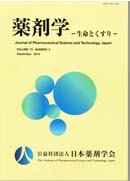64 巻, 3 号
選択された号の論文の15件中1~15を表示しています
- |<
- <
- 1
- >
- >|
巻頭言
-
2004 年 64 巻 3 号 p. 133
発行日: 2004年
公開日: 2019/05/10
PDF形式でダウンロード (147K)
フォーラム
-
2004 年 64 巻 3 号 p. 134-135
発行日: 2004年
公開日: 2019/05/10
PDF形式でダウンロード (184K) -
2004 年 64 巻 3 号 p. 136-137
発行日: 2004年
公開日: 2019/05/10
PDF形式でダウンロード (111K)
リレープラザ
-
2004 年 64 巻 3 号 p. 138-140
発行日: 2004年
公開日: 2019/05/10
PDF形式でダウンロード (294K) -
2004 年 64 巻 3 号 p. 141-145
発行日: 2004年
公開日: 2019/05/10
PDF形式でダウンロード (450K)
R&D
-
2004 年 64 巻 3 号 p. 146-149
発行日: 2004年
公開日: 2019/05/10
PDF形式でダウンロード (340K)
研究室紹介
-
2004 年 64 巻 3 号 p. 150-152
発行日: 2004年
公開日: 2019/05/10
PDF形式でダウンロード (654K)
若手研究者紹介
-
2004 年 64 巻 3 号 p. 153-158
発行日: 2004年
公開日: 2019/05/10
PDF形式でダウンロード (584K) -
2004 年 64 巻 3 号 p. 159-163
発行日: 2004年
公開日: 2019/05/10
PDF形式でダウンロード (525K)
最近のトピックス
-
2004 年 64 巻 3 号 p. 164-167
発行日: 2004年
公開日: 2019/05/10
PDF形式でダウンロード (348K) -
2004 年 64 巻 3 号 p. 168-171
発行日: 2004年
公開日: 2019/05/10
PDF形式でダウンロード (337K)
イントロダクション
-
2004 年 64 巻 3 号 p. 172-173
発行日: 2004年
公開日: 2019/05/10
PDF形式でダウンロード (175K)
ニュース・学会だより
-
2004 年 64 巻 3 号 p. 174-179
発行日: 2004年
公開日: 2019/05/10
PDF形式でダウンロード (640K)
一般論文
-
2004 年 64 巻 3 号 p. 180-185
発行日: 2004年
公開日: 2019/05/10
PDF形式でダウンロード (784K)
ノート
-
2004 年 64 巻 3 号 p. 186-191
発行日: 2004年
公開日: 2019/05/10
PDF形式でダウンロード (520K)
- |<
- <
- 1
- >
- >|
